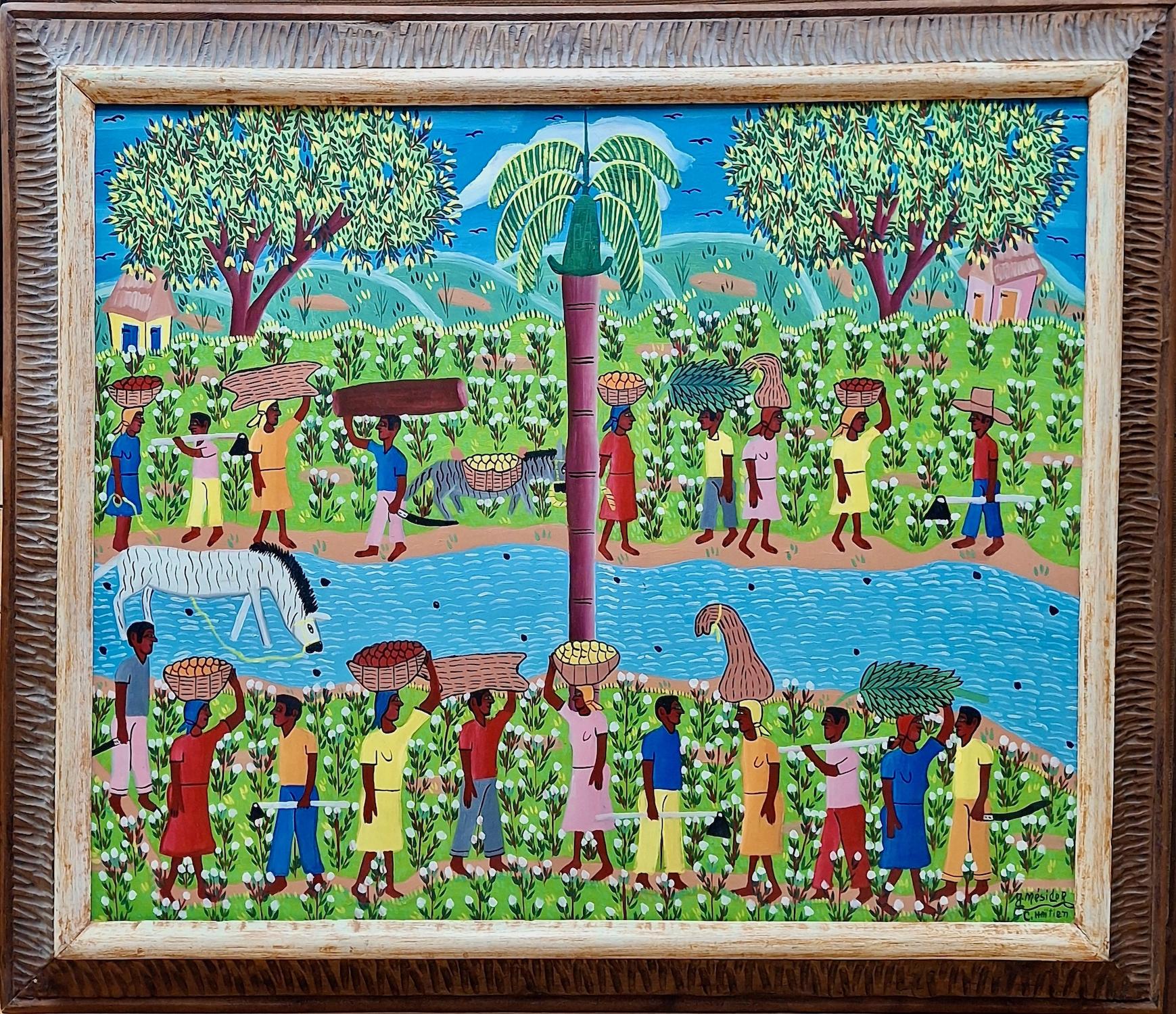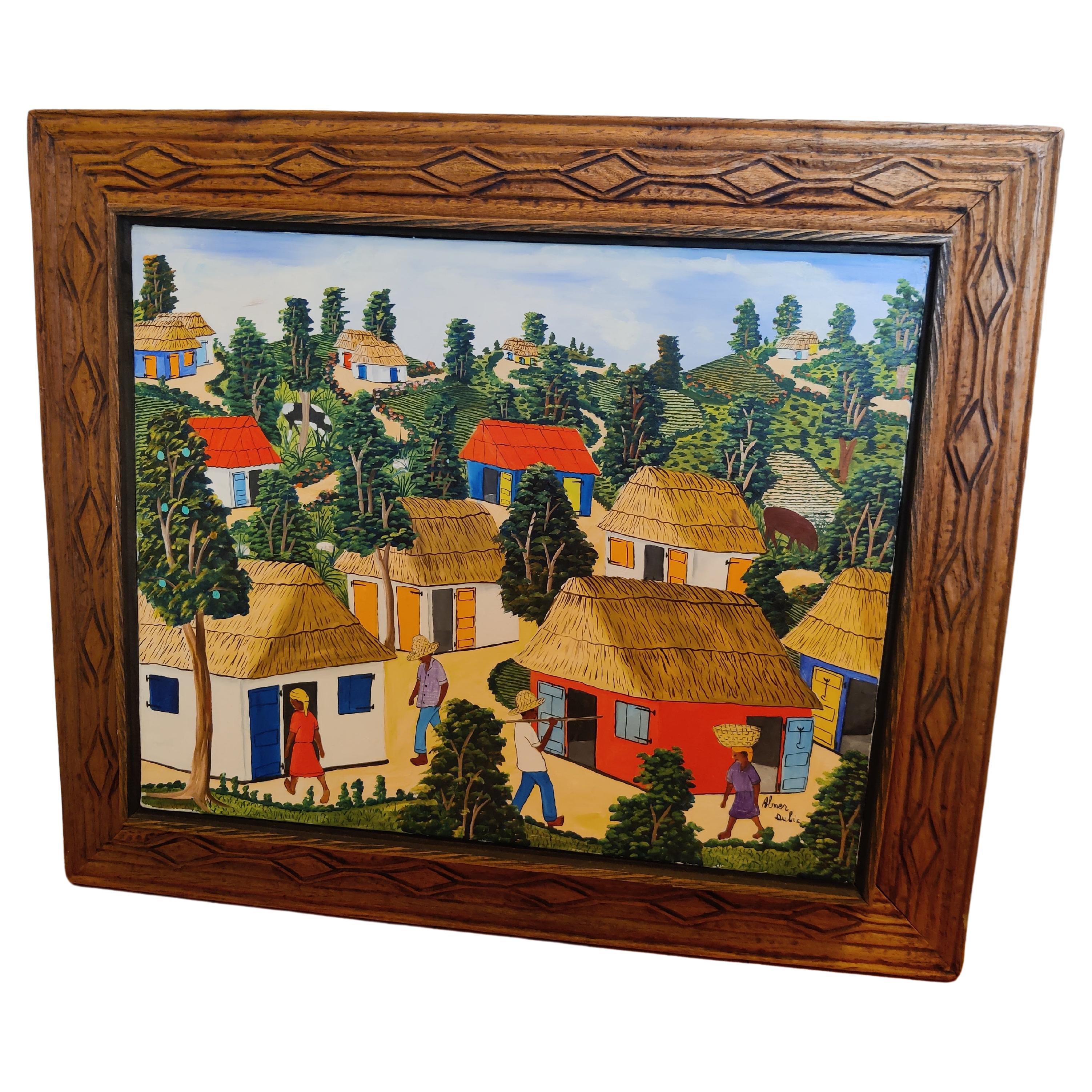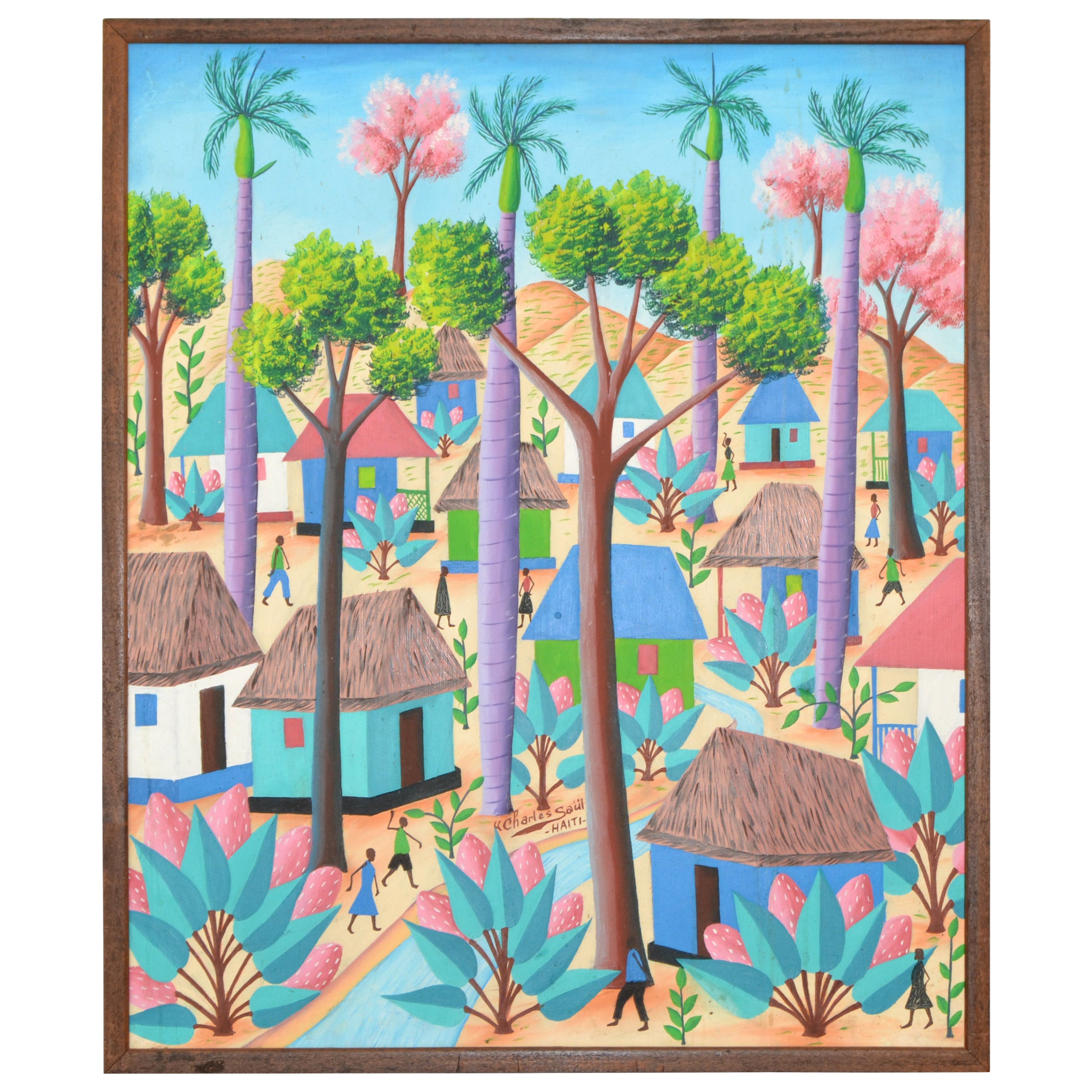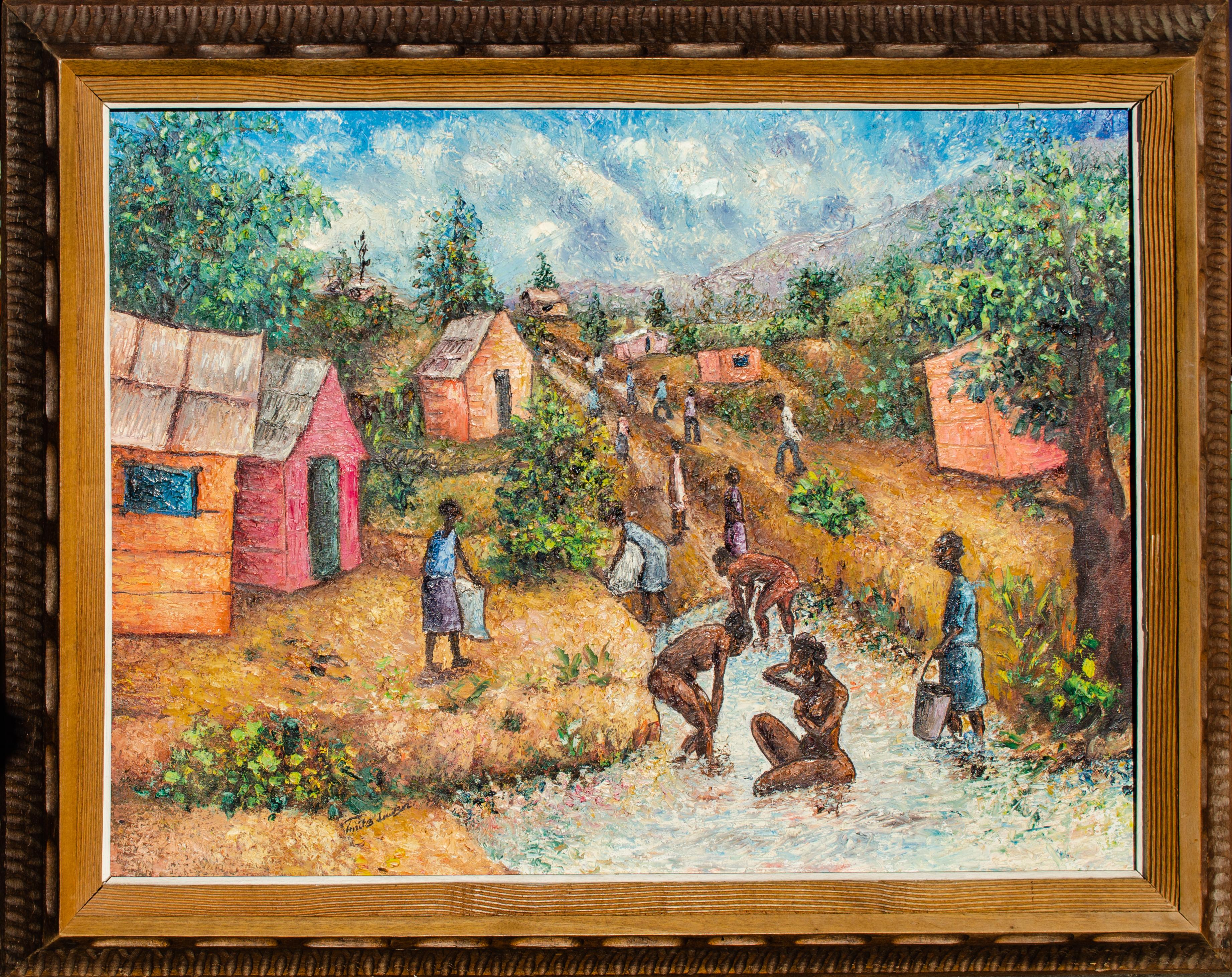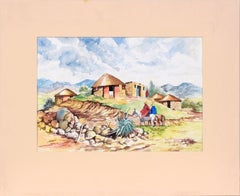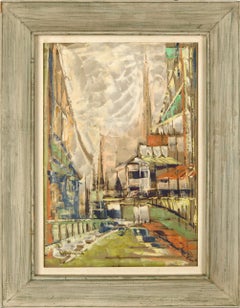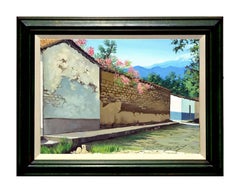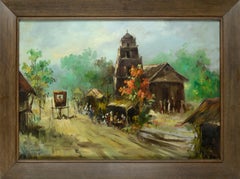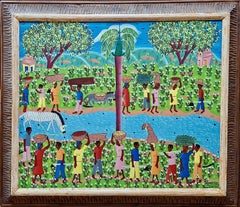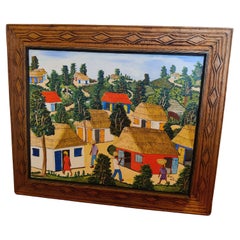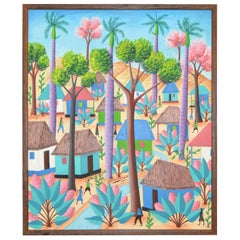Items Similar to Haitian Village Figurative Landscape
Want more images or videos?
Request additional images or videos from the seller
1 of 10
Frantz LamotheHaitian Village Figurative Landscapecirca 1990
circa 1990
$1,480
$1,85020% Off
£1,117.54
£1,396.9220% Off
€1,296.57
€1,620.7220% Off
CA$2,079.86
CA$2,599.8320% Off
A$2,317.26
A$2,896.5820% Off
CHF 1,209.72
CHF 1,512.1520% Off
MX$28,134.66
MX$35,168.3320% Off
NOK 15,205.40
NOK 19,006.7520% Off
SEK 14,372.80
SEK 17,96620% Off
DKK 9,678.76
DKK 12,098.4520% Off
About the Item
A gorgeous tempura painting of figures carrying goods and taking a break in a Haitian village by Frantz (Freddie) Lamothe (Haitian, b.1961). Signed "F. Lamothe" lower left. Presented in a wood frame. Image, 24"H x 24"L.
Frantz Lamothe was born in Haiti in 1961, but left to join his parents in New York at age 4. Living on the Brooklyn streets by the age of sixteen, he began painting as the graffiti artist ‘Frenchy’ on the subway trains of New York. This way of life came to an end when, along with fellow graffiti artists such as Jean-Michel Basquiat, Lamothe was taken up by the New York art world.
After Basquiat’s death, Lamothe decided to return to Haiti. Here, his work matured, combining its original urban, anarchic style with the vibrant colors of the Caribbean, and the sacred diagrams of Voodoo. Now internationally acclaimed, he has worked in France, Germany, Japan and the USA
Frantz Lamothe’s raw and visceral paintings reflect fragments of his varied past.
The combination of Haiti’s vibrant artistic life and political instability (he was there for the coup against Aristide in 1991), gave a new edge to his work. Combining his original anarchic street style with the vibrant colors of the Caribbean, and the sacred diagrams of Vodou, his work garnered international acclaim, and has been shown across Europe, Japan and the USA. Through all this turbulent history, his work continues to reflect a wild and brutally honest vision of the world.
- Creator:Frantz Lamothe (1961, Haitian)
- Creation Year:circa 1990
- Dimensions:Height: 29 in (73.66 cm)Width: 29 in (73.66 cm)Depth: 1 in (2.54 cm)
- Medium:
- Movement & Style:
- Period:
- Condition:
- Gallery Location:Soquel, CA
- Reference Number:Seller: JT-N67951stDibs: LU5428279502
About the Seller
5.0
Platinum Seller
Premium sellers with a 4.7+ rating and 24-hour response times
Established in 1986
1stDibs seller since 2014
2,982 sales on 1stDibs
Typical response time: <1 hour
- ShippingRetrieving quote...Shipping from: Soquel, CA
- Return Policy
Authenticity Guarantee
In the unlikely event there’s an issue with an item’s authenticity, contact us within 1 year for a full refund. DetailsMoney-Back Guarantee
If your item is not as described, is damaged in transit, or does not arrive, contact us within 7 days for a full refund. Details24-Hour Cancellation
You have a 24-hour grace period in which to reconsider your purchase, with no questions asked.Vetted Professional Sellers
Our world-class sellers must adhere to strict standards for service and quality, maintaining the integrity of our listings.Price-Match Guarantee
If you find that a seller listed the same item for a lower price elsewhere, we’ll match it.Trusted Global Delivery
Our best-in-class carrier network provides specialized shipping options worldwide, including custom delivery.More From This Seller
View AllSouth African Village - Landscape
Located in Soquel, CA
Highly detailed village scene by notable South African artist Tsepiso Lesenyeho (b. 1968). A cluster of houses sit atop a hill, against a dramatic backdrop of mountains and clouds. I...
Category
Early 2000s Impressionist Landscape Paintings
Materials
Paper, Ink, Watercolor
Abstract Village Scene Original Oil Painting
Located in Soquel, CA
Abstract decorative cityscape by Leonard "Parker Lee" Leibsohn (American, 1924 - 1995).
Known for: Abstraction and realism, landscape, marine and still lif...
Category
1970s Abstract Landscape Paintings
Materials
Acrylic, Illustration Board
$479 Sale Price
20% Off
Springtime in the Village, El Salvador Landscape
By Guardado Aguilera
Located in Soquel, CA
Bright and charming painting of springtime in an El Salvadorian village by Guardado Aguilera (Salvadoran, 20th Century), c.1980s. The artist shows a snapshot of a back street in a vi...
Category
1980s Impressionist Landscape Paintings
Materials
Oil, Board
$600 Sale Price
20% Off
Old Manila Street Scene, Mid Century Modern Figurative Landscape
Located in Soquel, CA
Mid Century Modern Old Manila Street Scene, 1960s Figurative Landscape
Beautiful mid century modern figurative landscape by Didi Fernandez (Filipino, 20th Century). This charming 1966 old Manila street scene, in the style of the well-known Filipino painter Cesar Buenaventura...
Category
1960s Impressionist Landscape Paintings
Materials
Canvas, Oil
$910 Sale Price
35% Off
Old House at Capistrano, Laguna Beach Figurative Landscape, CA Pioneer Artist
By Daisy A. Newell Kearns
Located in Soquel, CA
Old House at Capistrano, Laguna Beach Figurative Landscape by California Pioneer Artist Daisy A. Newell Kearns
Substantial and historic mid-1930's period...
Category
1930s American Impressionist Landscape Paintings
Materials
Canvas, Oil
Looking Down at the Ranch, Abstract Expressionist Landscape
Located in Soquel, CA
Heavily textured, 1962 abstracted landscape by Humbolt area artist Alma B. Leamey (American, 1901-1996). The viewer looks out over a valley, with a ranch at the focal point. In the d...
Category
Mid-20th Century Expressionist Landscape Paintings
Materials
Canvas, Oil
You May Also Like
Haitian Village
Located in San Francisco, CA
This artwork "Haitian Village" 1996 is a watercolor on paper by noted Haitian artist Martino Dorce, b.1943. It is signed and dated at the lower right cor...
Category
Late 20th Century Contemporary Landscape Drawings and Watercolors
Materials
Watercolor
A Haitian Country Scene
Located in San Francisco, CA
Haitian artist Jacksin Mésidor painted this from his Caribbean coastal hometown of Cap-Haitien in the north of his native land. As Haitian folk art, the painting delivers an archityp...
Category
20th Century Folk Art Figurative Paintings
Materials
Masonite, Oil
Abner Dubic original signed painting of Haiti Village Scene
Located in Cincinnati, OH
Abner Dubic original signed painting of Haiti Village.
Dubic was born 1944 in Haiti. Started painting in 1966. Exhibitions in Paris, Strasbourg, and US....
Category
Late 20th Century Haitian Paintings
Materials
Canvas, Paint
$712 Sale Price
64% Off
Charles Saül Framed Haitian Vintage Village Scene Acrylic on Canvas Painting
Located in Miami, FL
An original framed acrylic on canvas painting of a Haitian village scene with people going back and forth, huts, and tall foliage and palm trees.
Signed...
Category
Late 20th Century Haitian Folk Art Paintings
Materials
Canvas, Acrylic
Haitian Painting of Village Women Bathing
Located in New York, NY
Unknown Artist
Untitled (Haitian Women Bathing), c. 1970
Oil on canvas
24 3/4 x 32 in.
Framed: 30 1/8 x 38 in.
Signed illegibly lower left
Category
1970s Outsider Art Landscape Paintings
Materials
Canvas, Oil
"Landscape Scene of Mexican Villagers" Expressionistic Oil Painting on Masonite
By Michael Baxte
Located in New York, NY
A strong modernist oil painting depicted in 1971 by Russian painter Michael Baxte. Mostly known for his abstracted figures on canvas or street scenes, this piece is a wonderful representation of his landscape paintings, with expressive use of color, shape, and form. Later in his career, Baxte explores Expressionism, infusing both European and North American stylistic trends. This piece is from later in his career, but we can feel this underlying style throughout.
Art measures 18 x 21.75 inches
Michael Posner Baxte was born in 1890 in the small town of Staroselje Belarus, Russia. For the first half of the 19th century it was a center of the Chabad movement of Hasidic Jews, but this group was gone by the middle of the 19th century. By the time the Baxte family immigrated to the United States at the beginning of the 20th century, the Jewish population numbered only on the hundreds. The native language of the Baxte family was Yiddish. It is likely that the death of Michael Baxte’s father triggered the family’s immigration. Three older brothers arrived in New York between 1903 and 1905. Michael and his mother, Rebecca, arrived in 1907. By 1910 Michael, his mother, and brother, Joseph, were living in New Orleans and may have spent some time on a Louisiana plantation. Around 1912, Michael Baxte returned to Europe to study the violin. In 1914 he, his mother, and Joseph moved to New York City.
Meanwhile, in Algeria, a talented young woman painter, Violette Mege, was making history. Since for the first time, a woman won the prestigious Beaux Art competition in Algeria. At first, the awards committee denied her the prize but, with French government intervention, Mege eventually prevailed. She won again 3 years later and, in 1916, used the scholarship to visit the United States of America. When Violette came to New York, she met Baxte, who was, by then, an accomplished violinist, teacher, and composer. Baxte’s compositions were performed at the Tokyo Imperial Theater, and in 1922 he was listed in the American Jewish Yearbook as one of the prominent members of the American Jewish community. As a music teacher he encouraged individual expression. Baxte stated, “No pupil should ever be forced into imitation of the teacher. Art is a personal experience, and the teacher’s truest aim must be to awaken this light of personality through the patient light of science.”
By 1920 Michael Baxte and Violette Mege were living together in Manhattan. Although they claimed to be living as husband and wife, it seems that their marriage did not become official until 1928. On their “unofficial” honeymoon around 1917, in Algiers, Baxte confided to her his ambition to paint. There and later in New Mexico where the wonderful steeped sunlight approximates the coloring of Algiers, she taught him his heart’s desire. He never had any other teacher. She never had any other pupil. For ten years she devoted all her time, energy, and ambition to teaching, encouraging, inspiring him. Then in 1928, their mutual strivings were rewarded, as his works were being chosen as one of the two winners in the Dudensing National Competition for American Painters. Out of 150 artists from across the country participated in the Dudensing, and Michael Posner Baxte and, Robert Fawcett, were the winners.
In his 1924 naturalization application, he indicated that he was sometimes known as “Michael Posner Baxte.” One of the witnesses to his application was Bernard Karfiol, a Jewish American artist. That’s when Michael may...
Category
1960s Expressionist Landscape Paintings
Materials
Oil, Masonite
More Ways To Browse
Freddie Styles
Haitian Landscape
Vintage Bric A Brac
Vintage Burlesque Dancers
W B Moses
Woodruff Oil
Wormy Chestnut
Yves Calmejane
1940s Plantation Painting
19th Century Painting Girl With Dog
Alexej Ravski
Andrew Rush
Andrew Wyeth Book
Antique Spanish Guitars
Arthur Rubinstein
Brasserie Painting
David Ham
Diana Huntress Painting
